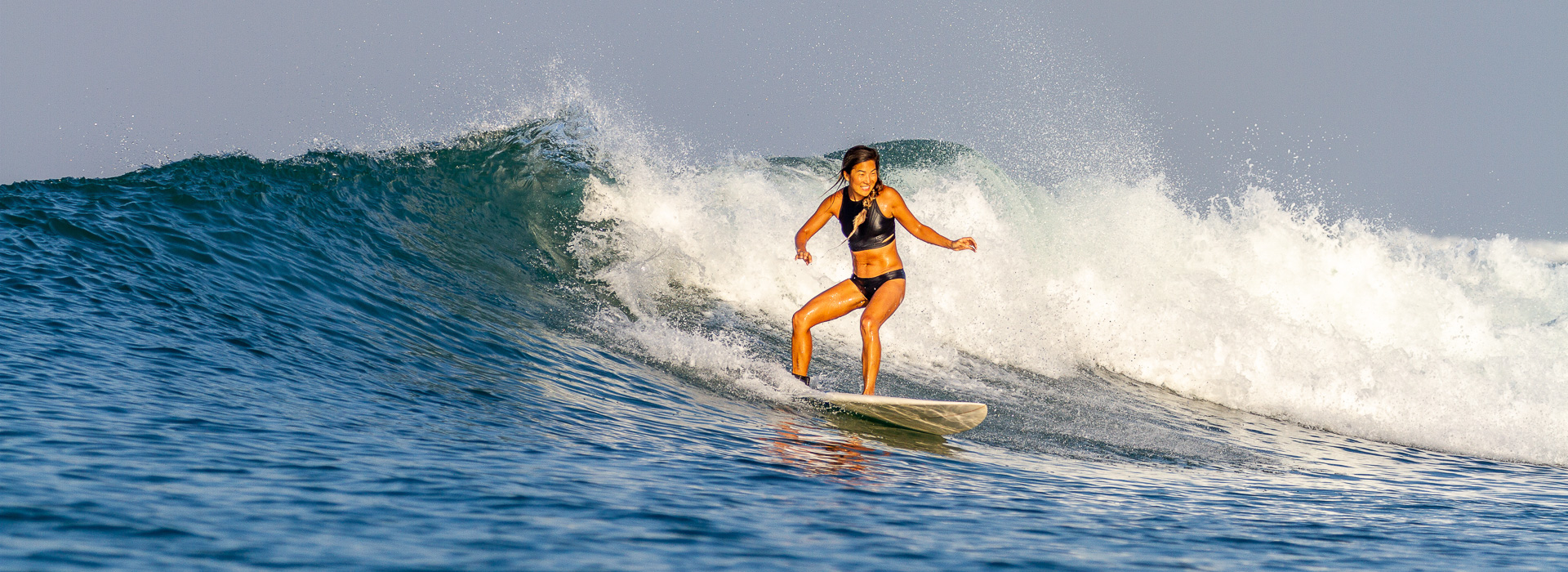
Steering and turning the surboard
When you choose to surf with Padang Padang Surf Camp, you will learn the correct way to surf. Our surf lessons are taught by the best local instructors who have years of experience in the breaking waves. Our experienced team has helped thousands of surfers begin their journey of riding waves.
The functional stance and the basics of turning are foundational skills for riding waves that you will acquire when you surf with us. These essential skills pave the way for ongoing development. Our surf camp offers the ideal environment for learning to surf as we guide you through each step of the process with in-depth video reviews and land-based coaching sessions to supplement our in-water surf lessons. All of this in a relaxed, social, surf-oriented environment. Begin your surfing journey with us, and set your course for surfing success!
Not Staying With Us? No Problem!
At Padang Padang Surf Camp, we believe that the joy of surfing should be shared with eveeryone. So that’s why we extend our surf lessons beyond our camp to reach everyone with a passion for surfing.
We’d love nothing more than for you to stay with us and immerse yourself in the complete surfing experience we offer at our surf camp. But we understand you may already have your accommodations arranged.
So, our world-class beginner and intermediate surf lessons are available to non-residents of our surf camp. If you want to progress quicker then we recommend private surf lessons.
We’re ready to welcome you, no matter where you’ve chosen to stay. Take the next step toward embracing beginner surf lessons in Bali by completing our surf school booking form for non-residents now.
Steering the Surfboard
Standing in the functional stance is the key component of controlling and steering the surfboard. Left arm controls the left rail and right arm controls the left rail. Standing correctly on the surfboard with your feet in the correct position, your arms high and your elbows bent will allow you to easily find your balance and control the surfboard.
Turning Frontside
Frontside turns, a turn when you are facing the wave, is a foundational manoeuvre that you will need to learn. Once you have the ability to ride along the face of the wave in the functional stance, you will need to learn to turn the surfboard. Frontside turns are used to control your position on the wave, which is essential for managing your speed and extending your ride. What will start as a frontside turn, will eventually develop into a bottom turn, which unlocks the next level of surfing.
Key Components of turning frontside
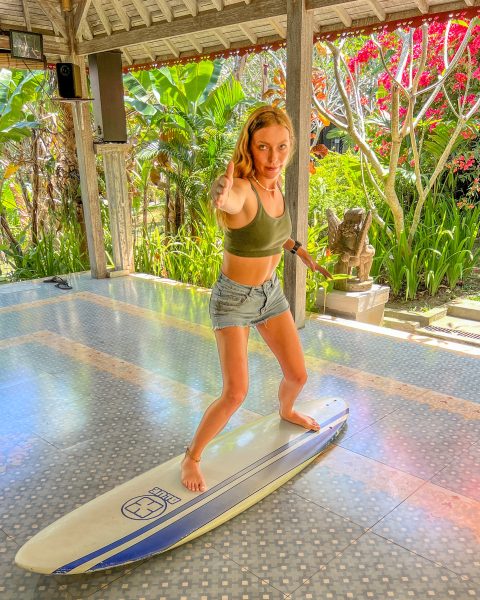
- Your leading arm should point where you want to go and over the rail. Moving your arm in your desired direction will move your weight towards your toes, which turns the surfboard on that side.
- Your leading arm and your nose should be aligned. This creates a synergy that guides your entire body through the turn.
- Most of your weight should be on your toes, which is facilitated by leaning your leading arm over the rail in the direction where you want to go. Most of your weight should be on the back foot when initiating the turn of the surfboard.
- Your knees should be bent to control the weight distribution between front foot and back foot, and heel/toe and allow rotational movement of your body.
- Hips and shoulders low to improve rotational movement, lower your centre of gravity and to increase stability.
Turning Backside
A backside turn, a turn facing away from the wave, is similar in concept to a frontside. The main difference is lowering the bum to put weight on the heels replaces the mechanism of the front side turn – where the kees control the weight distribtion on the toe side . Being able to turn both frontside and backside allows you to surf both left and right-breaking waves. This means more opportunities and faster improvement.
Key Components of turning backside
- Your leading arm should point where you want to go and extend over the rail.
- Your leading arm and your nose should be aligned. Just like in frontside turns, your leading arm and head alignment play a pivotal role in guiding your trajectory. By pointing where you want to go and aligning with your nose, you establish a clear path for your turn.
- Most of your weight should be on your heel side, which is facilitated by leaning your leading arm over the rail in the direction where you want to go. Most of your weight should be on the back foot when initiating the turn of the surfboard.
- Your hips and bum should be low to drop your centre of gravity. Bending your knees and lowering your bum is crucial in backside turns, as it controls the weight distribution to your heel.
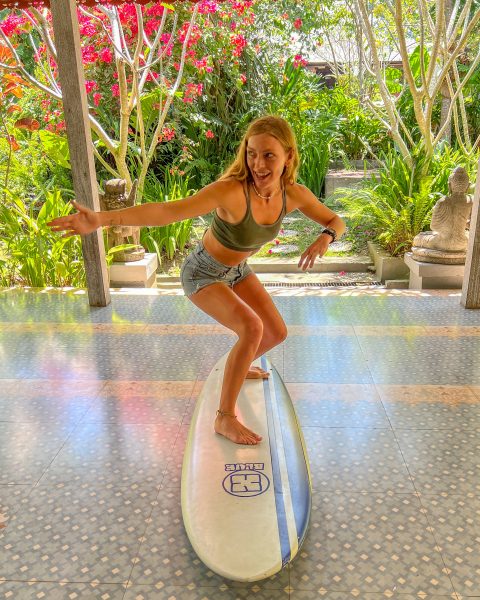
Practice on land
Reinforce this crucial skill set by practising with a surf-skate between sessions. The same movements and concepts can be seamlessly transferred to your muscle memory, whether you join us at our surf camp or carve your own path.
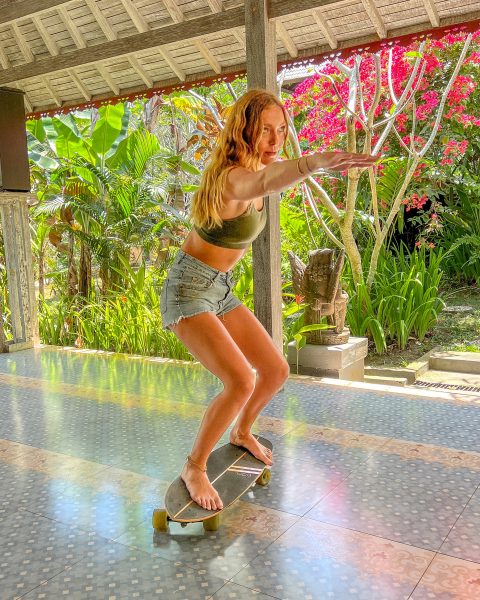
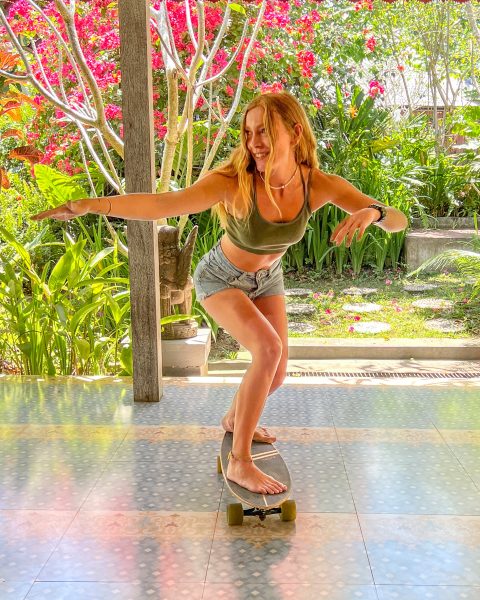
When just beginning your surfing journey, the functional stance and the basics of turning are fundamental building blocks to your development as a surfer. Without these skills, you will never advance to the next level. So, the next time you paddle out, remember that the functional stance is your ally, your guide, and your path to surfing with style and grace.
Next steps
Once you’ve mastered the functional stance and can confidently turn your surfboard both frontside and the backside, you can progress to more advanced turning techniques. Sharper turns, which are covered in intermediate surf lessons, build upon the fundamental principles you’ve already learned, but they require a bit more intensity and skill.
The key to executing sharper turns lies in how you distribute your weight between front foot and back foot, and heels/toes. The sharper you want to turn, the more you’ll need to lean in that direction. With time and repetition, you will learn to get your body low and lean over at the correct angle to match the degree of your turn. This precision is what makes for a crisp and controlled turn in surfing. To progress your surfing we recommend Yoga for strength and flexibility.
How to turn sharper
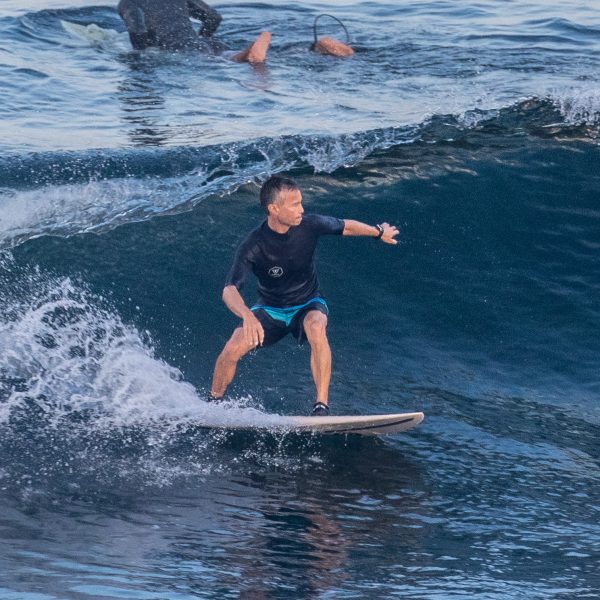
- Reach with your arm more perpendicular to your body, which causes you to lean your body over more towards the direction you are turning.
- Initiate the turn with most of your weight on the back foot.
- Weight distribution should be heavily on heel/toes – depending on direction of turn.
- Bend your knees and drop your shoulders to lower your centre of gravity, which further engages the rail and the fins of the surfboard.
START YOUR SURFING ADVENTURE IN BALI TODAY
You know what we’re all about at Padang Padang Surf Camp. We offer expert instruction and comprehensive surf training tailored to you as a beginner surfer. Our highly experienced, Australian-standard instructors have successfully coached countless beginners. Are you ready to be our next success story?
We invite you to join us and surf the beginner-friendly surf destinations in Bali that are all within easy reach of our surf camp. The thrilling sensation of riding your first wave, the sense of accomplishment as you master a new skill, and the enchanting beauty of Bali are waiting for you here at Padang Padang Surf Camp.
Your journey of an unrivalled surfing adventure begins here. Simply click on the Book Now button below and secure your spot, or get in contact with us, and we will reply to you as soon as possible.
We invite you to join our surf camp and surf school, where our experienced instructors will guide you through the art of surfing while ensuring your safety and enjoyment.
Whether you’re a complete beginner or looking to take your skills to the next level, you’ll get expert instruction and support.
Reach out to us today and begin your surfing journey.